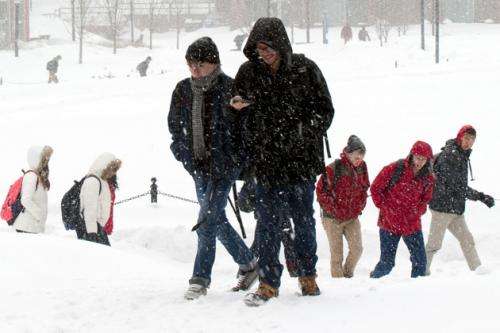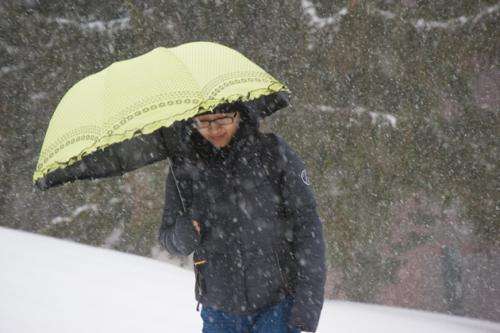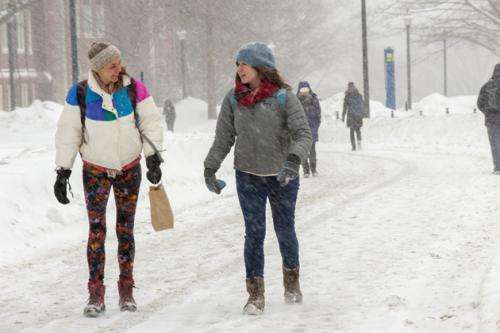Avoiding winter health hazards

Have you had enough of winter? UConn Today sought out experts at UConn Health for a roundup of common threats to our health and well-being this time of year. Their information won't make spring come any faster, but it may keep you safe.
Recognize the signs of hypothermia
"Patients are always surprised at two things: how quickly hypothermia sets in, and the feeling of being slow," says Dr. Rebecca Andrews, UConn Health primary care physician.
"Your brain cannot function as well with hypothermia and you may feel confused, fatigued, sleepy and uncoordinated."
She explains that time exposed is just as important as temperature, and even temperature in the 40s can be problematic depending on age, health, blood flow, and whether the body is wet or dry. She also advises planning for emergencies. "Let friends and family know where you are going in case you have car trouble. Keep blankets and a candle and something to light it with in the car in case of breakdown. A lit candle can heat the inside of a car, but be sure to roll down a window just enough to allow the smoke to escape."
Frostbite can cause permanent tissue and nerve damage
Andrews says that toes, fingers, ears, nose, and other areas exposed to the cold with less fat to insulate them and less blood supply are especially at risk for frostbite.
"Initially the cold can cause red, painful skin. This is the time to slowly rewarm your hands indoors. If left untreated, the area then becomes numb, pale, and can feel hardened when ice crystals form in your skin," Andrews says.
And, she adds, frostbite can be misleading. "Believe it or not, the cold, painful, tingling sensation can be followed by your hands feeling warm. Please, do not be fooled into thinking your hands are warming up; this is a sign of serious damage. Sometimes we even see blisters as the skin is rewarmed. Any of these signs of frostbite – white, hard skin, blisters, and swelling after rewarming with persistent numbness or tingling – need to be addressed by a health care provider."
Shovel a path on your walk and you could be shoveling a path to heart attack
Snow shoveling can be a high-stakes stress test, and those with coronary artery disease shouldn't do it, says Dr. Peter Schulman, general cardiologist who has seen many patients at UConn Health's Pat and Jim Calhoun Cardiology Center who've had a heart attack after shoveling.

Schulman says, "Shoveling is the 'perfect storm' for a heart attack. It's cold, it's usually in the morning, which is when most heart attacks occur, being under pressure to get to work or school can cause increased anxiety, and it's strenuous activity that you may not be used to doing. If you do have to shovel, be sure to avoid dangerous cold, dress in layers, don't overdo it, and take frequent breaks."
He adds that now's not the time for heart patients to miss their meds. "Especially aspirin, beta blockers, and statin drugs, which lower cholesterol – these drugs can all be protective immediately after taking to lower your heart attack risk," Schulman says.
The type of snow shovel you use really can make a difference
Use an ergonomically designed shovel that minimizes bending or a shovel with a lightweight plastic blade, says Dr. Joseph Walker, physiatrist (pain management specialist) at the UConn Musculoskeletal Institute, who also recommends warming up thoroughly, pacing yourself, and taking frequent breaks. If the snow is deep, work your way to the surface a few inches at a time rather than digging from the bottom.
"The most common injury I have seen this winter season," he says, " has been muscle strain/overuse injuries, in the old and the young. Typically these injuries are caused by repetitive motions used in shoveling and snow blowing and can lead to overuse muscle strain injuries. Overuse injuries occur from stress on the bone, muscle, tendon or ligament. Over time these stresses cause the tissue to become inflamed and weaken."
Better yet, use a snow blower
Snow blowers are friendlier to the lower back and shoulders than are snow shovels, but these machines also introduce another danger.
"It would seem obvious not to put your hand in the snow blower," says Dr. Cory Edgar, UConn Health orthopedic surgeon. "As the engine goes, there's potential energy within the gears, and when it gets stuck, whether it's a stick or heavy snow, in the heat of the moment or perhaps in a moment of confusion, people may reach in to unclog it.
"What people don't realize is, even when the engine is totally off, freeing the clog can also release the built-up energy in the engine. If you use your hand to do this, it can cause serious damage, including loss of fingers. It happens more than you might think."
Watch your step

What about the snow that's not removed and turns into ice? "UConn Health's trauma patient admissions were up 47 percent in January due largely to injuries caused by people slipping and falling on the ice," says paramedic Peter Canning, UConn Health's emergency medical services coordinator. He says it serves as a reminder to people to put ice melt on steps and driveways, wear appropriate shoes with good traction, and be sure to carry a cell phone when going outside to be able to call for help if they do fall.
Unsafe generators can kill you
"Generators should always be run outside the home, at least 20 feet from any windows or doors." says Amy Hanoian Fontana, community education specialist at the Connecticut Poison Control Center. Less obviously, when snow piles up around the house it can block vents that are supposed to exhaust emissions from things like dryers, furnaces, fireplaces or wood stoves. If the CO can't get out, it will back up in your home. That's why you need at least one working smoke detector in the house.
CO poisoning can be persistent and is not always easy to recognize, she adds.
"It is very difficult to explain the dangers of CO when it is in fact so intangible," Hanoian Fontana says. "Sometimes an exposure to CO results in neurological problems like memory loss and trouble concentrating several weeks after the event. These effects can range from mild to severe. Most people, even first responders, think of CO only as a hazard to be handled right at the moment it happens. Truth is, CO can have lingering effects that can be concerning."
It's not just CO this time of year.
The Connecticut Poison Control Center also has been known to get calls about poisonings related to siphoning of gasoline by mouth to fuel a snow blower, acid from corroded batteries, and chemical ice melt products splashing into eyes or ingested by children. The message is clear, no matter how frustrated you are by the weather, think before you act.



















